![]()
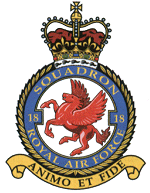 Although not at Wattisham for very long, 18 Squadron
is one of the few that is still active today.
Although not at Wattisham for very long, 18 Squadron
is one of the few that is still active today.
Northolt was the site for the birth of 18 Squadron on 11 May 1915, which was formed from Nr 4 Reserve Squadron. A brief move to Norwich (Mousehold) for training was made on 16 August, the squadron acquiring a gamut of aeroplanes such as Bristol Scouts, Shorthorns and Martinsydes but eventually was sent to the Western Front and the horrors of the Great War flying the Vickers FB Gunbus. Flying tactical reconnaissance missions, it saw action over the trenches of the Somme flying from bases such as St Omer, Bertangles and Auchel. DH4s were provided in 1917 and DH9As shortly before the war's end. Disbandment came on 31 December 1919 at Weston-on-the-Green.
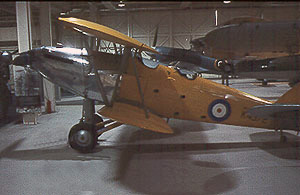 The first of many reformations for the squadron
came on 20 October 1931 when two Hawker Harts were supplied to the fledging
unit at Upper Heyford in Oxfordshire. Forming the backbone of the RAF's
light bomber fleet in the thirties, the Hart was to be a common sight
in the Oxford skies for the first half of the decade, especially so in
the colours of 18 Squadron. Hinds replaced the Harts in 1936, hardly a
giant leap in capability, but were to remain in service for two years
before Blenheims were available. At this time a brief move to Bircham
Newton in Norfolk was made, but by September of that year the squadron
was back at Upper Heyford. At Bircham 'C' Flight was detached to Worthy
Down to form the nucleus of 49 Squadron.
The first of many reformations for the squadron
came on 20 October 1931 when two Hawker Harts were supplied to the fledging
unit at Upper Heyford in Oxfordshire. Forming the backbone of the RAF's
light bomber fleet in the thirties, the Hart was to be a common sight
in the Oxford skies for the first half of the decade, especially so in
the colours of 18 Squadron. Hinds replaced the Harts in 1936, hardly a
giant leap in capability, but were to remain in service for two years
before Blenheims were available. At this time a brief move to Bircham
Newton in Norfolk was made, but by September of that year the squadron
was back at Upper Heyford. At Bircham 'C' Flight was detached to Worthy
Down to form the nucleus of 49 Squadron.
The start of the war saw 18 Squadron provide aerial reconnaissance over France for the British Expeditionary Force, flying from an airfield near Amy. Such was the devastating effect of the Battle of France that most of the squadron was lost in those frenetic months, the unit being withdrawn to England in the early summer of 1940. Returning to Lympne in Kent, the surviving Blenheims were quickly dispersed to less vulnerable locations, most going to Watton in Norfolk.
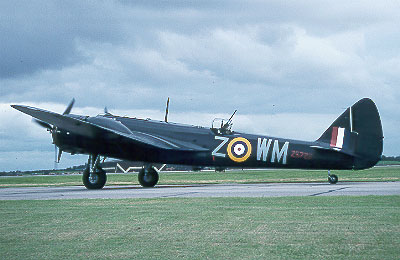 Reformed at Gatwick (yes, now the airport) and equipped with Blenheim
IVs, coded 'WV', the squadron moved to West Raynham on 12 June, staying
here for three months before moving all of a mile to the nearby satellite
airstrip of Great Massingham. The first squadron to use Massingham, from
here the unit flew night missions against enemy airfields and also provided
diversionary raids for the heavy bomber fleet. In April '41 it moved to
north Norfolk and another rudimentary airfield at Oulton, satellite airfield
for Horsham St Faiths. From here and the parent airfield, still using
the redoubtable Blenheim, by now the Mk IV, tactics changed to the anti-shipping
role. Detachments were sent to Manston for Operation Channel Stop as with
other light bomber units, and during this time on 19 August the squadron
made a 'humanitarian' mission by dropping a new metal leg to the captured
Wing Commander Douglas Bader in St Omer! Carried by Blenheim R3843 WV-F,
naturally enough this mission was titled 'Operation Leg'.
Reformed at Gatwick (yes, now the airport) and equipped with Blenheim
IVs, coded 'WV', the squadron moved to West Raynham on 12 June, staying
here for three months before moving all of a mile to the nearby satellite
airstrip of Great Massingham. The first squadron to use Massingham, from
here the unit flew night missions against enemy airfields and also provided
diversionary raids for the heavy bomber fleet. In April '41 it moved to
north Norfolk and another rudimentary airfield at Oulton, satellite airfield
for Horsham St Faiths. From here and the parent airfield, still using
the redoubtable Blenheim, by now the Mk IV, tactics changed to the anti-shipping
role. Detachments were sent to Manston for Operation Channel Stop as with
other light bomber units, and during this time on 19 August the squadron
made a 'humanitarian' mission by dropping a new metal leg to the captured
Wing Commander Douglas Bader in St Omer! Carried by Blenheim R3843 WV-F,
naturally enough this mission was titled 'Operation Leg'.
In July, the squadron departed for pastures new in the beautiful island of Malta to bolster the defence of the beleaguered population but returned to Oulton in the November, for rest and recuperation. A month later came departure for Wattisham, although the squadron was somewhat depleted with some crews still in the Mediterranean. As mentioned before, its stay at Wattisham was brief as by August 1942 it had moved back to Great Massingham. Provided now with Blenheim VDs (commonly known as the Bisley), it left for the Middle East in October.
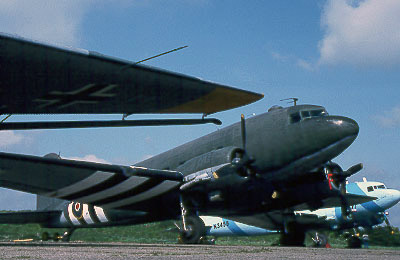 Algeria was the destination, from here the
squadron mounted raids on German targets in Tunisia but suffered heavy
losses in the early daylight missions. A switch to night missions was
made and also a change of aircraft, from the Blenheim to the Boston III.
A move to Sicily in August 1943 and onwards into Italy in October saw
the squadron see out the war mounting raids on Northern Italy and the
Balkans from bases such as Brindisi, still in use today. Immediately after
VE day the squadron moved to Aviano, where today much military action
is seen, then post-war it moved to Hassini in Greece, where disbandment
came on 31 March 1946. A brief resurrection came in September 1946 when
621 Squadron was renumbered at Ein Shemer in Palestine, but swiftly disbanded
a mere two weeks later.
Algeria was the destination, from here the
squadron mounted raids on German targets in Tunisia but suffered heavy
losses in the early daylight missions. A switch to night missions was
made and also a change of aircraft, from the Blenheim to the Boston III.
A move to Sicily in August 1943 and onwards into Italy in October saw
the squadron see out the war mounting raids on Northern Italy and the
Balkans from bases such as Brindisi, still in use today. Immediately after
VE day the squadron moved to Aviano, where today much military action
is seen, then post-war it moved to Hassini in Greece, where disbandment
came on 31 March 1946. A brief resurrection came in September 1946 when
621 Squadron was renumbered at Ein Shemer in Palestine, but swiftly disbanded
a mere two weeks later.
Such short duration lives continued, as on 15 March 1947 18 Squadron re-emerged as a meteorological unit at Butterworth in Australia but lasted barely eight months before disbandment yet again. A more permanent reformation occurred on 8 December of the same year at Netheravon with Dakotas on charge, three days later moving out to Waterbeach, near Cambridge. Sterling service was provided a year later during the Berlin Airlift, the squadron detached to Germany for the duration. Returning in October 1949, it moved briefly to Oakington before settling back at nearby Waterbeach before disbanding on 20 February 1950.
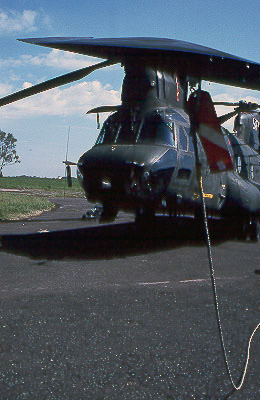 Three years later at Scampton, 18 Squadron re-emerged
with Canberra B2s on 1 August 1953. With Scampton being chosen as a V-bomber
base the unit relocated to Upwood in 1955, the squadron forming part of
the Upwood Wing at the Cambridgeshire base and seeing action in the Suez
crisis the following year. Another disbandment came on 1 February 1957
as flying at Upwood was wound down but the squadron was re-born on 16
December 1958 at Finningley, this time from 'C' Flight of 199 Squadron
as a specialist V-bomber unit flying the doomed Vickers Valiant. Tasked
with radio and radar jamming, it was an unusual squadron within the V-bomber
fleet, as it carried no weapons or bombs.
Three years later at Scampton, 18 Squadron re-emerged
with Canberra B2s on 1 August 1953. With Scampton being chosen as a V-bomber
base the unit relocated to Upwood in 1955, the squadron forming part of
the Upwood Wing at the Cambridgeshire base and seeing action in the Suez
crisis the following year. Another disbandment came on 1 February 1957
as flying at Upwood was wound down but the squadron was re-born on 16
December 1958 at Finningley, this time from 'C' Flight of 199 Squadron
as a specialist V-bomber unit flying the doomed Vickers Valiant. Tasked
with radio and radar jamming, it was an unusual squadron within the V-bomber
fleet, as it carried no weapons or bombs.
Presented with a standard by Princess Margaret on 14 June 1962, the squadron again faced disbandment the following year as by now most aircraft in Bomber Command carried their own electronic counter-measures. So, on 31 March 1963, again 18 Squadron disbanded.
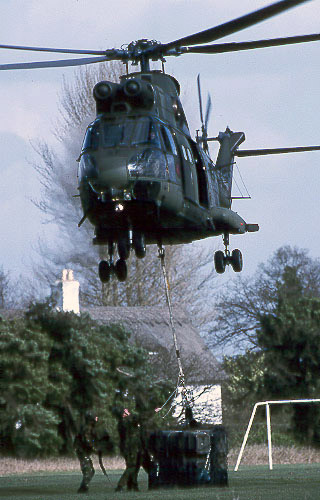 Another change of role became
the squadron in 1964 as it reformed at Odiham in Hampshire with the Wessex
HC2, moving to Gutersloh in West Germany during 1965 as an Army support
unit. During the next three years regular detachments to Nicosia were
made in support of UN operations. A brief return to the UK in 1969 saw
the squadron use Acklington in Northumberland for operations until it
returned first to Odiham, then back to Gutersloh in August 1970. Yet another
disbandment on 30 November 1980 preceded nine months of inaction before
its most lengthy time of continuous service, which continues today.
Another change of role became
the squadron in 1964 as it reformed at Odiham in Hampshire with the Wessex
HC2, moving to Gutersloh in West Germany during 1965 as an Army support
unit. During the next three years regular detachments to Nicosia were
made in support of UN operations. A brief return to the UK in 1969 saw
the squadron use Acklington in Northumberland for operations until it
returned first to Odiham, then back to Gutersloh in August 1970. Yet another
disbandment on 30 November 1980 preceded nine months of inaction before
its most lengthy time of continuous service, which continues today.
Chosen to be the first user of the mighty Chinook in 1981, the squadron converted to the new beast on 4 August. Barely six months later came the squadron's biggest test since the Berlin Airlift, when the Argentines took control of the Falkland Islands and 18 Squadron found itself embarked on the Atlantic Conveyor for duties in the South Atlantic. Hit by an Exocet missile, the ship was lost but one of the four Chinooks survived (ZA718/BN) and performed sterling work in the land battles that followed, carrying 1,500 troops, 600 tons of equipment and 650 prisoners of war in 150 sorties.
A move back to West Germany occurred during 1984 as the squadron relocated to Gutersloh once again as part of the Royal Air Force Germany and remained, there and later at Laarbruch, through the tumultuous times of the late eighties and early nineties. During this time the squadron also operated the Puma HC1 as support to the Chinook operations, but on return to the UK in 1997 these were relinquished to 33 Squadron at Benson. Now relocated at Odiham as part of the Chinook Wing, it enters a new millennium as part of the Joint Helicopter Force under a multi-force command structure and a with a bright future ahead of it.